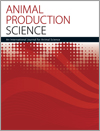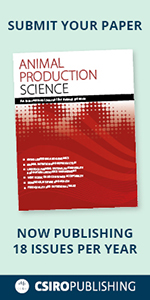
Animal Production Science
Volume 61 Number 8 2021
The current greenhouse gas emission (GHG) indicators in sub-Saharan African are discussed are worrisome, yet sub-Saharan African governments are facing challenges that range from lack of funding, community complexities, and research tools needed to create a database of GHG emission values based on direct measurements. These governments view and rank adaptation and/mitigation strategies of GHG as priority and there is need to evaluate anthropogenic and environmental components that influence ecosystem functions.
AN20275Genome-wide association study between copy number variation regions and carcass- and meat-quality traits in Nellore cattle
 , Marcos Vinícius de Antunes Lemos, Tatiane Cristina Seleguim Chud, Nedenia Bonvino Stafuzza, Sabrina Kluska, Sabrina Thaise Amorim, Lucas Silva Ferlin Lopes, Angélica Simone Cravo Pereira, Derek Bickhart, George Liu, Lúcia Galvão de Albuquerque and Fernando Baldi
, Marcos Vinícius de Antunes Lemos, Tatiane Cristina Seleguim Chud, Nedenia Bonvino Stafuzza, Sabrina Kluska, Sabrina Thaise Amorim, Lucas Silva Ferlin Lopes, Angélica Simone Cravo Pereira, Derek Bickhart, George Liu, Lúcia Galvão de Albuquerque and Fernando Baldi
Indicine breeds are the main source of beef products in tropical and subtropical regions. Thus, the knowledge of genetic variants that influence meat-quality traits should help improve the beef industry. Genomes studies to understand structural genetic variants are still limited in indicine cattle. The results of the present study will help improve and understand the genetic mechanisms involved in the expression of beef and carcass traits in Nellore cattle.
Buffalos, as animals well adapted to difficult living situations, are a main source for protein, milk and meat production. This study was aimed at evaluating different breeding strategies in Iranian native buffaloes, using stochastic simulation, in order to determine optimal selection designs. Application of open nucleus breeding schemes along with genomic selection is recommended for improving the productivity in the Iranian buffalo population.
AN20121Feed conversion efficiency in sheep genetically selected for resistance to gastrointestinal nematodes
 and I. De Barbieri
and I. De Barbieri 
The possibility of identifying animals resistant to diseases while maintaining or increasing production and feed conversion efficiency is a major challenge for the future of the sheep industry, but it may be limited by potential antagonism among these traits reported in the literature. To test this, we studied the relationship between feed efficiency, animal performance and gastrointestinal parasite resistance. The main conclusion is that breeding resistant animals to gastrointestinal nematodes would not have a negative effect on feed conversion efficiency.
AN20121 Abstract | AN20121 Full Text | AN20121PDF (267 KB) Open Access Article
Smallholder enterprises use locally available forages, but inclusion of cassava tuber and gliricidia supplement could promote bull liveweight gain and time to market. Two separate on-farm experiments were conducted to evaluate increasing supplementation levels of a cassava tuber and gliricidia. Ongole and Bali bulls increased their feed intake, weight gain and feed efficiency through supplementation up to the level 1.6%W/day. Increased supplement intake was associated with a doubling of daily income over food costs.
AN20297 Abstract | AN20297 Full Text | AN20297PDF (298 KB) Open Access Article
Pastures that reduce the dairy nitrogen impact on the environment and increase milk production are desirable. Plantain is such pasture; however, limited knowledge on its inclusion rates in diets to make such a difference has not been generated. Including 15–60% plantain in dairy pastures reduced nitrogen in urine and maintained milk production similarly to ryegrass white clover. The implications of these results indicate that dairy farms may maintain milk production and emit less harmful nitrogen into water sources.
AN20325Effect of three weaning methods on behavioural, cortisol and weight changes in buffalo calves
 , Herlinda Bonilla-Jaime
, Herlinda Bonilla-Jaime  , Héctor Orozco-Gregorio
, Héctor Orozco-Gregorio  , Juan M. Vargas-Romero
, Juan M. Vargas-Romero  , Ariel M. Tarazona-Morales
, Ariel M. Tarazona-Morales  , Maribel M. Estévez-Cabrera
, Maribel M. Estévez-Cabrera  and Patricia Roldán-Santiago
and Patricia Roldán-Santiago 
Weaning is a stressful practice in calves when the mother–calf bond is still strong and these might have important implications for animal welfare and productivity. After total separation from their mothers, abrupt weaning and two-step weaning with nose-flaps in buffalo calves generate physiological and behavioural responses, compared with fence-line. Thus, fence-line weaning could be implemented in buffalo calves in meat production systems to promote their welfare during weaning.
AN20056Influence of calf vigour and suckling assistance from birth to weaning in Guzerá beef cattle
 , Luara Afonso de Freitas, Gabriele Voltareli da Silva, Sérgio Brasil Garcia Pimenta Neves Pereira Lima, Joslaine Noely dos Santos Gonçalves Cyrillo, Nedenia Bonvino Stafuzza, Maria Lúcia Pereira de Lima and Claudia Cristina Paro de Paz
, Luara Afonso de Freitas, Gabriele Voltareli da Silva, Sérgio Brasil Garcia Pimenta Neves Pereira Lima, Joslaine Noely dos Santos Gonçalves Cyrillo, Nedenia Bonvino Stafuzza, Maria Lúcia Pereira de Lima and Claudia Cristina Paro de Paz
Calf development is important for the productivity of beef cattle and the herd efficiency is assured if each cow produces a calf every year. Guzerá beef cattle are a relevant breed in Brazil, but studies investigating the effect of maternal care and vigour on calf development in this breed are scarse. Calf vigour and human assistance at birth can be applied in farm management to prevent pre-calving losses, improving the calf growth until weaning.
AN18767Prediction of dry matter intake by feedlot beef cattle under tropical conditions
 , A. B. Donadia
, A. B. Donadia  , L.F. Moreno
, L.F. Moreno  , A.S. de Oliveira
, A.S. de Oliveira  , E. H. B. K. Moraes
, E. H. B. K. Moraes  and K. A. K. Moraes
and K. A. K. Moraes 
Dry matter intake (DMI) is the basis for the calculation of nutritional requirements for maintenance and production; therefore, accurate predictions is essential. A meta-analysis was conducted to develop DMI prediction models for feedlot beef cattle under tropical conditions, and to evaluate and compare the new models against those proposed by others prediction systems. The proposed models were evaluated to be the most suitable for the DMI prediction of beef cattle under tropical conditions.
AN20449Effects of grass- and concentrate-based finishing systems on the quality of meat from the M. longissimus thoracis of young Sarda bulls
 , Mauro Decandia, Valeria Giovanetti, Carla Manca, Corrado Dimauro, Salvatore Pier Giacomo Rassu, Margherita Addis and Giovanni Molle
, Mauro Decandia, Valeria Giovanetti, Carla Manca, Corrado Dimauro, Salvatore Pier Giacomo Rassu, Margherita Addis and Giovanni Molle
The consumer’s attention towards food origin, animal welfare, environmental protection and healthy products has increased the demand for meat from animals reared under grazing systems. The Sarda cow play a prominent role in the conservation of the extensive systems. Grazing, by improving meat nutritional quality, can represent an opportunity for the Mediterranean beef system. This work has shown that grazing increased nutritional quality of Sarda bulls meat, improving some nutritional indexes (i.e. n-6:n-3 ratio) and this feeding system can be traced back, for the purpose of its recognition and valorisation



